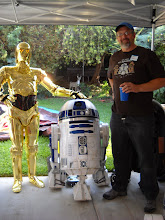
I only bring up the mistake because I did this once and ruined a pair of horseshoes that I had put a lot of work into.
I have a plunge attachment for this router but I don't like it. I just drill a small pilot hole into the center of the shoulder and then I work that hole down onto the pin sticking up in the picture. To start, I set the router height very low and turn on the router and ease the piece down onto it. Then I gently rotate the whole leg around that axis point at the pin and the bit does all of the work. The danger here is that a dull bit, or a mistake will rip out a nasty section in the beautiful perfect legs that I've worked on so hard. Routers operate at very high speeds so the slightest mistakes invariably spin into big gouges that tear across the face of your work piece. I did several test runs with this set up before actually putting one of the legs on here. Once the groove is started, I change the depth on the bit until it has cut to the 1/2" or so depth I'm shooting. This is a tricky operation, and the details of how you do it will vary depending on your tools. There are some very nice circle jigs for routers out there, but I don't think many of them will scale all the way down to a 3.35" diameter. Another option would be to use a collar and a circle template. Here's the results of the first circle that I get:

The cut is clean and perfectly round. So I'm happy. Once I got it set up, I ran all four legs through.
For the shoulder hubs to sit down into the legs, there needs to be another smaller circular pocket down inside of this one. Check the plans for the shoulder hub. You'll see that it has a stepped profile. But I've got an empty chamber in there that I left for the wiring. You can see that I already made a round hole in that chamber, but I wasn't planning ahead very well. The bit I used to round out the top of the hollow chamber in the legs was a 2 1/8" door knob hole cutter. But I need a 2.5" diameter hole here. So I've got a problem. Now that the plug is popped out, there's no material for the pin to ride in for the router jig:

That is, I set my router circle cutter to the 2.5" diameter and started cutting, but when I got down to this depth, the piece that the router pin was sticking into popped loose because there's nothing holding it in. In the picture you can see the diameter of the hole that I need. It's just a bit bigger than the one that is in there. I hope that makes sense. So what I'm going to do is put a 2.5" hole saw bit on the drill press. Then I'll get this piece centered just right and clamped down under the drill press bit and I'll cut the large inner circle down to the right depth that way. Then I think I'll be able to pop that plug out with a chisel. I'll show more pictures when I get to it. But here's a really valuable tip. When you are doing the initial cutting out and you get to the middle layer of plywood that has the channel down the middle for wiring:

Make this circle that's at the top of the channel 3" in diameter. That way you won't have to do this extra work when you go to cut the pockets for the shoulder hub. Make sense?
The one other thing I did yesterday was glue and clamp the curved ankle details to the outer legs:

This is a pretty easy step. I put a couple of pins into the leg and then drill the curved pieces to accept them. And when I say "pins," all I mean is that I am taking a small finish nail and cutting it off with some pliers, then I'm sticking that down into the work piece. The pins keep the work pieces from drifting out of alignment when they are under the clamping pressure. As before I put enough glue evenly spread around both gluing surfaces to ooze out of the sides all the way around. That was all the gaps will be filled for finishing and painting work and I'll have a good bond. Resist the temptation to clamp these too hard. The MDF is prone to get dents and it doesn't take much pressure to make a really strong bond.







No comments:
Post a Comment